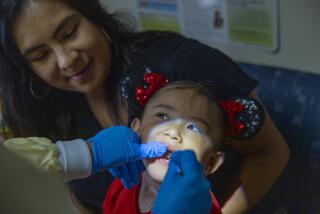Helping Kids, Parents Face a Difficult Fact
- Share via
Almost as if they were mirror images, the two girls slowly walked toward each other, each touching her ear.
“It almost brought me to tears,” said Chris Fradkin, 43, who until that moment had worried that his daughter had been born into a life of loneliness and isolation. “It was a powerful image that I’ll never forget.”
At that moment, Ruby Jaye Fradkin, who was then 18 months old, saw for the first time another child with a “baby ear.”
Ruby Jaye was born with a condition called hemifacial microsomia. One of her ears is not fully formed and one side of her jaw is slightly smaller than the other.
It took three weeks for Fradkin and his wife to discover the name of the condition, but months more to find anyone who understood what they had been going through.
They found that understanding at a support group in New York, where they lived for a short time when Ruby Jaye was a toddler.
“That moment was the beginning for us,” said Fradkin, a sound effects editor and songwriter. “All of a sudden the battle stopped and the battle turned into: ‘There’s challenges we have to deal with, but who cares? We’re not alone with this.’ ”
But after returning to Southern California, Fradkin found no support group of that kind here.
So in August, Fradkin--now divorced and living in Sherman Oaks--created the Craniofacial Support Network of Southern California.
The first meeting was held in a coffee shop. The monthly meetings are now held at the Sherman Oaks Lutheran Church.
The group has about half a dozen families, and new members are invited. Members say finding someone who has dealt with the same problems can make all the difference. Parents compare strategies in dealing with doctors and ways of coping until corrective surgery can be performed.
Ruby Jaye, who is now 6, has found her own way to deal with classmates asking about her condition. “That’s my baby ear,” she tells them. “When I’m 7 years old, the doctor is going to open it like a flower and make it big like the other one.”
Kathy Quezada of Huntington Park enjoys sharing her experiences at the meetings, which can last as long as four hours.
“Unfortunately for me, I haven’t found somebody with the same type of condition my daughter has,” Quezada said.
Her 7-year-old, Erika, was born with a large tumor on the floor of her mouth which has left her face misshapen. Erika easily talks about her condition, even though strangers often stop and stare at the girl.
“She has dealt with it very well,” Quezada said. “I prefer people to be open and ask them to talk to me about it.”
The best advice Quezada can give to new parents of children with facial deformities is to “accept it, and don’t try to hide it from them,” she said.
When Erika was born, Quezada asked for the tumor to be covered with a blanket. But the nurse objected and threatened to take the baby away from her.
“No, don’t cover her--I want her,” said Quezada, grateful that the nurse had taken such a harsh stance. “From then on I overlooked everything. I stopped seeing a tumor. I saw my daughter.”
The Craniofacial Support Network of Southern California can be reached at (818) 754-4600.
Personal Best is a weekly profile of an ordinary person who does extraordinary things. Please send suggestions on prospective candidates to Personal Best, Los Angeles Times, 20000 Prairie St., Chatsworth 91311. Or fax them to (818) 772-3338. Or e-mail them to valley@latimes.com
More to Read
Sign up for Essential California
The most important California stories and recommendations in your inbox every morning.
You may occasionally receive promotional content from the Los Angeles Times.













